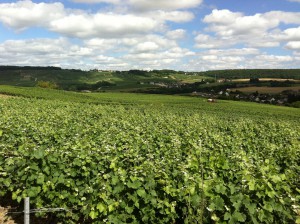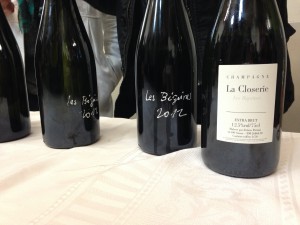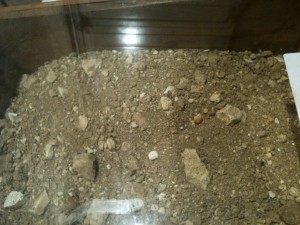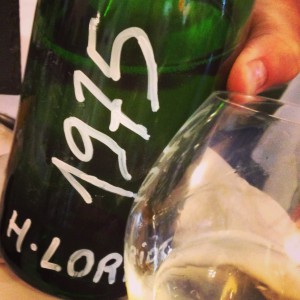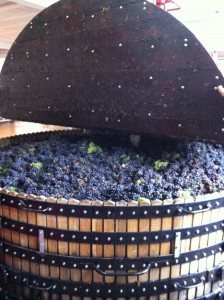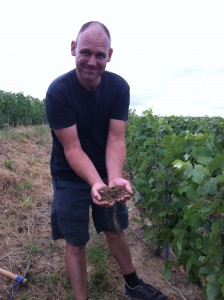When the Champagne appellation was defined in 1927 (and formalized in 1936) – the powers who were at the time decided Meunier was not noble enough to be granted Grand Cru status; this exceptional status was reserved for the noble Burgundian Chardonnay and Pinot Noir. When the Grand Cru status was revised in 1988 and a few villages were upgraded to one hundred percent on the Cru scale, Meunier once again was left behind; after all the grape variety is too fickle to guarantee quality when the desired quantity becomes too high. And with quantities increasing in Champagne to meet market demand, it was obvious that Chardonnay and Pinot Noir were safer choices.
However the grape variety started to make a slow comeback toward the end of the nineties, when several visionary vignerons saw the true potential of pure Meunier cuvees.
In 1987 Jérome Prévost inherited two hectares of vineyard in Geux from his grandmother. The Beguines vineyard had been planted with Meunier (massale selection) in the fifties and the vines had been rented out previously, but Jérome decided to give grape growing a go. He wanted to make a terroir Meunier and went to work for Selosse for a while to learn the finer details of the trade. He made his first Champagne in 1998 under the name La Closerie – Les Beguines. It was one of the first single vineyard, single vintage Meuniers of the region. More importantly it was delicious and it very quickly became a cult wine when it was first released a few years later. Around the same time, Benoit Tarlant also decided to make a single vineyard single vintage Meunier. La Vigne d’Or (meaning the golden vine) comes from an old plot of Meunier in the village of Oeilly, where the Meunier vines – again by massale selection – had been planted on Sparnacien soil by his grandfather in the forties. Only 1000 to 1200 bottles are produced in the years the family decides to make the wine. Unlike Prévost, Tarlant ages the cuvee extensively (ten years); by doing so Tarlant furthermore shatters the myth that Meunier does not age. La Vigne d’Or is a rich and layered Champagne with an amazing salinity and freshness. A few villages further down the Marne river in Festigny Michel Loriot has been making pure Meunier for quite a long time. Festigny is considered by many as one of the best terroirs to grow Meunier. Loriot makes two pure Meunier cuvees today: Authentic Meunier, which is a fresh and fruit forward easy drinking Champagne and the more complex and round Monodie en Meunier Majeur, a vintage champagne made from seventy years old vines of the very steep south-west facing slopes of the village. I was lucky enough to taste a bottle of freshly disgorged 1975 Loriot pure Meunier about 3 weeks ago and rather than being old or over the top this Champagne was very vinous, layered and complex with a very fresh finish – proving once again that Meunier can age very well.What all three growers have in common is that they work well in the vineyard. Furthermore they work at the rhythm of the Meunier rather than at the appellation rhythm. By this I mean they produce less quantity of better quality, harvesting the grapes when they are at their optimum.
This makes for richer, silkier wines – with a texture and structure which often reminds me of crushed velvet. The ripe fruit characteristics and sweet pastry notes Meunier can develop when it is grown and harvested this way are very seductive and pleasurable: personally I find them very miammiam and morish!!
Dehours makes two single vineyard, single vintage Meunier cuvees: La Croix Jolie and Les Genevreaux. La Croix Jolie is only bottled in Magnum and comes from a very low yielding old vine Meunier vineyard. Most of the vineyard is used to produce Jerome’s Coteau Rouge (Still red wine). The fruit is left to ripen fully – Jerome is always one of the last one to harvest in the Valley – making for an intense, complex Champagne. Les Genevreaux comes from an adjacent vineyard planted in 1979. Both vineyards have poor decarbonized clay soils, which accounts for the rich texture of both Meuniers.
A new and happy discovery for me at the Champagne a Table event was David Bourdaire. We tried two of his Meuniers – one white and one rosé. Champagne Bourdaire-Gallois is based in Pouillon in the Massif de St Thierry, at the very north of the Champagne appellation. His soils are a combination of sand, clay and limestone and Meunier is thriving in his vineyard. His entry level Non Vintage Champagne (Brut Sans Année) is made exclusively from Meunier and it is a very easy drinking fruit forward Champagne. The Meunier in Pouillon has characteristics of rich stewed stone fruit and naturally tastes sweet. David does two versions of this wine – the younger one has a dosage of around 6 grams, whilst the older one has no added sugar added at all. The Rosé is bursting with sweet red fruit flavours and pairs beautiful with red fruit deserts. It really is a very seductive Champagne – and it sets an example of how Meunier can shine as a Rosé as well!There are a few other excellent Meunier cuvees that I briefly want to mention here. Cedric Moussé Special Club is a mouth watering pure Meunier from Cuisle (Vallée de la Marne). In 2012 he also made a Special Club rosé and I can hardly wait to taste the finished product especially since I was lucky enough to taste the vin claire.
Nathalie Falmet very recently released an exclusive single vineyard Meunier cuvee called ZH302. Only a thousand bottles have been made, and pure Meunier from the Aube is really pretty rare. The packaging is gorgeous and the Champagne is simply delicious.
Benoit Dehu has pioneered one of the most fascinating Meunier projects I know of – he makes a white Coteau Champenois, a red Coteau Champenois and a Champagne all from the same vineyard exclusively planted with Meunier in Fossoy (in the Aisne – Grande Vallée de la Marne). I have tasted all three recently at Origine Champagne, and even if the three wines are still a little too young right now, they are very promising. Again I am impatient to revisit these cuvees in a few years time!
A last Meunier I want to mention here is the very morish Rosé de Saignée by Cyril Jeaunaux. Jeaunaux is based in Talus-St-Prix, at the beginning of the Vallée du Petit Morin. About half way between the Cotes des Blancs and the Sézannais, it is a little haven for Meunier in a sea of Chardonnay.

